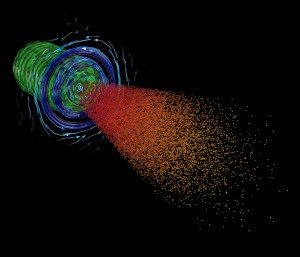Star power

OSIRIS simulation on Sequoia of the interaction of a fast-ignition-scale laser with a dense deuterium-tritium plasma. The laser field is shown in green. The blue arrows illustrate the magnetic field lines at the plasma interface. The red/yellow spheres are laser-accelerated electrons that will heat and ignite the fuel.
A postdoctoral fellow at Lawrence Livermore National Laboratory is leading exhaustive computer modeling efforts to study a new approach to controlled fusion.
“It is critical to simulate these (fusion) systems as best we can before doing experiments,” says Frederico Fiuza, who is in Livermore’s Fusion Energy Sciences Program. “The complexity is so large and building and using these machines is so expensive that you need to know as best as you can what to expect.”
Fiuza spent much of his recently completed doctoral research embellishing OSIRIS, a modeling code to tackle uncertainties surrounding what’s called the fast-ignition approach to inertial-confinement fusion. He loaded OSIRIS on all 1,572,864 cores of Sequoia, the lab’s IBM Blue Gene/Q, achieving what Livermore says is the biggest simulation ever with that kind of program.
Fiuza has received 19.5 million processor hours for follow-up work on Mira, a smaller Blue Gene at Argonne National Laboratory. Fiuza’s award is through the Department of Energy Advanced Scientific Computing Research Leadership Computing Challenge program.
“I’m sure the time we have with Mira is going to be extremely useful and productive, but it will also give rise to new ideas we will want to test,” says Fiuza, eager to apply for even more computing hours.
“When we try to achieve fusion in a controlled way in the laboratory, we are trying to meet the conditions that exist in the sun,” Fiuza says, “which is in the state of a plasma” – charged particles interacting with magnetic fields.
The plasma physicist is driven by the aims of the National Ignition Facility (NIF): to channel what lights up stars into a controllable device delivering essentially carbon-free energy. “That is the beautiful thing about fusion energy,” he says. “In theory it allows us to have a clean and safe energy source that is very abundant.”
Because fusion fuels are largely derived from hydrogen isotopes found in water, each gallon of the ocean could produce the energy of 300 gallons of gasoline. Similarly, 50 cups of water have energy equivalent to two tons of coal. Such gains follow from Albert Einstein’s most famous formula: The helium atoms produced in a fusion reaction are slightly less massive than the hydrogen isotopes feeding it. Since Einstein’s equation posits that mass equals energy, that slight excess is converted to heat.




